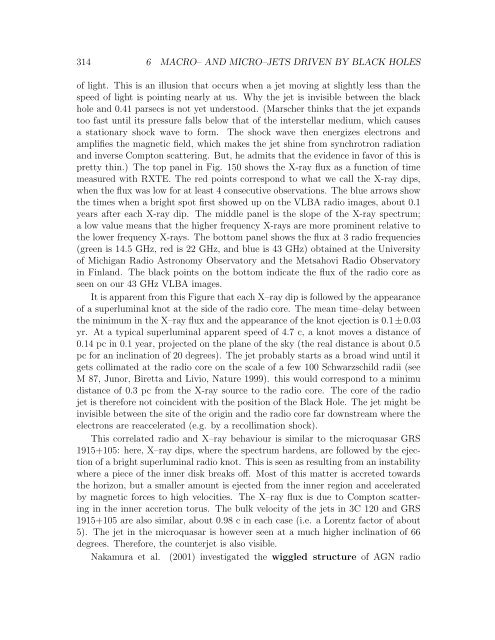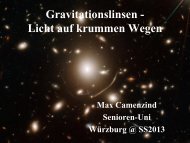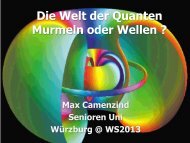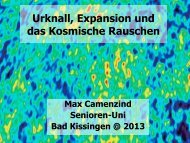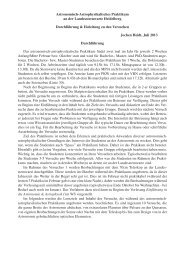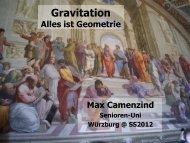Contents List of Figures
Contents List of Figures
Contents List of Figures
Create successful ePaper yourself
Turn your PDF publications into a flip-book with our unique Google optimized e-Paper software.
314 6 MACRO– AND MICRO–JETS DRIVEN BY BLACK HOLES<br />
<strong>of</strong> light. This is an illusion that occurs when a jet moving at slightly less than the<br />
speed <strong>of</strong> light is pointing nearly at us. Why the jet is invisible between the black<br />
hole and 0.41 parsecs is not yet understood. (Marscher thinks that the jet expands<br />
too fast until its pressure falls below that <strong>of</strong> the interstellar medium, which causes<br />
a stationary shock wave to form. The shock wave then energizes electrons and<br />
amplifies the magnetic field, which makes the jet shine from synchrotron radiation<br />
and inverse Compton scattering. But, he admits that the evidence in favor <strong>of</strong> this is<br />
pretty thin.) The top panel in Fig. 150 shows the X-ray flux as a function <strong>of</strong> time<br />
measured with RXTE. The red points correspond to what we call the X-ray dips,<br />
when the flux was low for at least 4 consecutive observations. The blue arrows show<br />
the times when a bright spot first showed up on the VLBA radio images, about 0.1<br />
years after each X-ray dip. The middle panel is the slope <strong>of</strong> the X-ray spectrum;<br />
a low value means that the higher frequency X-rays are more prominent relative to<br />
the lower frequency X-rays. The bottom panel shows the flux at 3 radio frequencies<br />
(green is 14.5 GHz, red is 22 GHz, and blue is 43 GHz) obtained at the University<br />
<strong>of</strong> Michigan Radio Astronomy Observatory and the Metsahovi Radio Observatory<br />
in Finland. The black points on the bottom indicate the flux <strong>of</strong> the radio core as<br />
seen on our 43 GHz VLBA images.<br />
It is apparent from this Figure that each X–ray dip is followed by the appearance<br />
<strong>of</strong> a superluminal knot at the side <strong>of</strong> the radio core. The mean time–delay between<br />
the minimum in the X–ray flux and the appearance <strong>of</strong> the knot ejection is 0.1 ± 0.03<br />
yr. At a typical superluminal apparent speed <strong>of</strong> 4.7 c, a knot moves a distance <strong>of</strong><br />
0.14 pc in 0.1 year, projected on the plane <strong>of</strong> the sky (the real distance is about 0.5<br />
pc for an inclination <strong>of</strong> 20 degrees). The jet probably starts as a broad wind until it<br />
gets collimated at the radio core on the scale <strong>of</strong> a few 100 Schwarzschild radii (see<br />
M 87, Junor, Biretta and Livio, Nature 1999). this would correspond to a minimu<br />
distance <strong>of</strong> 0.3 pc from the X-ray source to the radio core. The core <strong>of</strong> the radio<br />
jet is therefore not coincident with the position <strong>of</strong> the Black Hole. The jet might be<br />
invisible between the site <strong>of</strong> the origin and the radio core far downstream where the<br />
electrons are reaccelerated (e.g. by a recollimation shock).<br />
This correlated radio and X–ray behaviour is similar to the microquasar GRS<br />
1915+105: here, X–ray dips, where the spectrum hardens, are followed by the ejection<br />
<strong>of</strong> a bright superluminal radio knot. This is seen as resulting from an instability<br />
where a piece <strong>of</strong> the inner disk breaks <strong>of</strong>f. Most <strong>of</strong> this matter is accreted towards<br />
the horizon, but a smaller amount is ejected from the inner region and accelerated<br />
by magnetic forces to high velocities. The X–ray flux is due to Compton scattering<br />
in the inner accretion torus. The bulk velocity <strong>of</strong> the jets in 3C 120 and GRS<br />
1915+105 are also similar, about 0.98 c in each case (i.e. a Lorentz factor <strong>of</strong> about<br />
5). The jet in the microquasar is however seen at a much higher inclination <strong>of</strong> 66<br />
degrees. Therefore, the counterjet is also visible.<br />
Nakamura et al. (2001) investigated the wiggled structure <strong>of</strong> AGN radio


